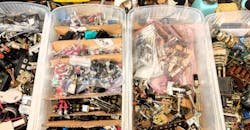Download this article in PDF format.
Back in February 2011, a mechanical engineer pal wrote me complaining about the complexity of switch catalogs and the difficulty in using them. My pal is no slouch, having brought many products to manufacturing. He is an expert in SolidWorks and MasterCAM, and dabbles in UNIX. He is fantastic at research, and has a great broad-based analytic mind. So him complaining about switch catalogs was not due to any lack of intellect. Channeling British Top Gear presenter Jeremy Clarkson, he wrote,
“This is quite simply the most complex switch catalog... in the world. And unlike any other switch catalog, this switch catalog seems to have been organized in such a way as to confound every effort to extract a useful part number for a working combination of switch, actuator rod, door, face or direct mounting "system" and knob, or whatever silly name they give it.
“I'm designing a product that needs a 3 pole, 220-240VAC, 6-10kVA disconnect for the mains in. I had hoped to find a compact unit that could be mounted internally with an external knob. I budgeted about 10 minutes for this task. Clearly, I'm off by a factor of 100.
“I realize it's easy to paste a bunch of pictures and spreadsheets into Acrobat Pro, but the only folks on this planet that could parse this catalog are the people that wrote it, with the help of a team of 4 or 5 engineers and a code breaker, and maybe an Enigma machine.”
This hit a real nerve, and it launched me into a rant about troubles I had deciphering both switch and connector catalogs. I swear to gosh, the problem of incomprehensible switch catalogs has driven me nuts for 20 years. Connector catalogs deserve the same derision. It’s a classic case of people "preaching to the choir." They think everybody knows what they know, so what kind of idiot does not realize the detailed differences between red-brick connectors and 0.093-inch terminal connectors?
A software consultant friend calls these types of catalogs “reductionist.” It’s like software manuals that say, "To edit the figure, click edit." There’s no intent, no analog in the explanation. There’s nothing to tell you what’s important.
Catalogs Can Be Very Taxing
Switch and connector catalogs are like the tax code, completely incomprehensible. One day, some software genius will scrub the connector web sites and make a Turbotax for connector and switch selections. It still won't tell you the big picture of why. Yet with a simple web interface, it could let you walk through the blizzard of selection parameters and at least make you understand what was mutually exclusive "Backlit momentary pushbuttons cannot use the T6 bulb color panel option." Oh, everybody knows that, at least everybody that has worked as a switch application engineer most of his or her life.
It’s not a matter of being patient to figure it out. It’s a matter of working at a company for 40 years, so you know the history and use of the products. "No, no, no, everybody knows that you aren't supposed to use silver contacts for logic signals!" I would like to get a switch apps engineer drunk and listen to him talk for four hours. Then I might be able to use the catalog.
What you have to do is ignore the catalog; it is an icon, a relic. Even if you figure out the part numbering and options, there will be a 20-week lead-time and they might charge you NRE (non-recurring engineering) or require a minimum order of 50 switches costing 38 dollars each. Instead, go to Newark first, then DigiKey/Mouser/Allied, and see what is in stock and how much of it is in stock. That tells you what people use. Be sure to view the .pdf catalog page that the switch is listed on, and browse back and forth five pages or so. That will tell you what else is in the category. If there are five 1-inch switch manufacturers, and you have the room, use that. Once you have a part number, Electronic Design has partnered with SourceESB and you can paste in the part number and see what distributors carry it and the pricing and stock.
I copied my rant to Bob Pease and a large list of fellow analog engineers. I began to worry that my chewing up the carpet might have a friend recommend my involuntary commitment to a mental hospital. To my delight, Mark Thoren, staff scientist at Linear Technology, replied an hour and a half later. Mark wrote:
“Ha Ha Ha Ha!!! Wow, I never realized others felt the same way I did. This was a fun rant to read. You know why it was fun? Because whenever I design a circuit with a switch, I use something from my junkbox (Fig. 1). If I need to go to production, I find a way to get someone else to choose the exact part number. How I do this is one of my little secrets. But let's just say that there are some people in this world that actually get satisfaction from finding that perfect switch. I'm not one of them.
“As far as connectors, I used to hate them just as much. Then I met Bill Kottmeier, my local Samtec rep, who completely rocks. All my connector troubles disappeared in an instant. Whenever I need a connector, I call him and he sets me up, considering all orthogonal variables such as availability (easily #1), esoteric nature, signal integrity, PCB layout-ability, recommended phase of moon during reflow, and much more obscure metrics like current capacity and number of pins. And I always tell Kottmeier to bring his briefcase of the latest and greatest samples because there's always something good. A year after meeting him, I can draw a picture of some whiz-bang connector with a preschool-size crayon and he'll pull a part number out of thin air.
Those Junk Box Switches
At the same time Eric Schlaepfer, then at Maxim Integrated, now at Google, wrote:
“You gotta watch out for the junk box switches that have high contact resistance (Fig. 2). Other than that, I've got about four boxes full of various types of switches. That would make for a fun video someday. Switches do have a lot of subtleties. My favorite is the "wetting current.”A large switch meant for controlling motors and heavier loads will fail much faster if you use it to switch logic levels. These switches need a larger current to flow to crack through any oxides that may have formed on the contact surface. Too little current does not apply enough cleaning action. I agree the Samtec guys are really good. I use their connectors all the time.”
It was only an hour later that fellow Croatian Andy Turudic teased me, “I think the fundamental problem with you on this subject is that switches are not pots. Switches are on or off, two states—digital. So, no matter what the switch guys do, an analog digital-averse purist such as yourself is a fish out of water. Let me tell you about latching switches and your eyes will glaze over. Audio taper pots on the other hand... LOL.”
After this enlightening repartee, Bob Pease replied in his inimitable fashion:
“Thanks for the amusing and nasty and accurate comments on catalogs.” He agreed with Eric, that it was true that we have to be careful using switches from the junkbox. As to the subtleties of switches, Pease observed, “For sure. Some switches are quite OK for switching 1000-ohms or 100kΩ, but they may leak compared to 10MΩ. Some switches are up above 10GΩ , but very few are guaranteed to do so under conditions of warmth or dampness. Especially if the frame or case is cheap nylon. For more than a minimum amount of such work, you may have to use special drivers for fancy reeds. Recently a guy asked me how to find switches or reeds that would leak less than 0.01 pA at 200 volts at one end. I said it was easy. I told him how to paint conductive rings around the reed. Then he wanted to do this in a size smaller than a TO-18 can. Sorry... / rap”
With regards to Turudic’s comment that switches were digital, Pease opined, “We would like to hope so, but we've just agreed, that in real switches, whether the junkers in my junk-box, or the best switches I can buy, there are other states, like somewhat leaky, or not exactly zero ohms. Those are not perfect, except when viewed through a very crude view. Yeah, sometimes that's wrong. But often right. / rap”
Bob Pease was right that there is a whole science to guard rings for high-impedance circuits. Pease’s hand-picked protege, Texas Instruments’ Paul Grohe has some great advice on using them. On a side note, to get a sense of Paul's range of talents, check out this video of him weighing an eyelash with his microgram scale:
Don’t think that switches are trivial or simplistic compared to semiconductors. When I tried to switch a logic signal with a high-quality silver contact switch, I learned you needed gold-plated contacts to reliably switch logic signals. When I tried to use a 5-A switch on my Harley headlight, I learned that 25-A switch is a better safety margin for a 4-A headlight, which has a large inrush current.
Switching inductive loads is also tough on switches, as is switching dc. When I worked at GMC Truck and Coach in the 1970s, they showed me how much less life they got out of switches used on 24-V trucks. When I built a 48-V switching power supply, I learned 48 V was a great arc-welding voltage. I needed 200-V dc-rated switches to control the output.
So maybe it’s not switch catalogs that are the problem. Maybe the problem is that we trivialize all those subtleties Eric Schlaepfer talks about. We need to devote as much time to our switches and connectors as we devote to op amps and processors. And yeah, it’s a good idea to make friends with the Samtec rep, as well as reps and application engineers from all manufacturers of any part you use in your design. As to my pal’s original problem, next time he might just drive over to a local electrical distributor and ask what they have on the shelf that would do the job. It beats trying to make sense of a catalog.
About the Author

Paul Rako
Creative Director
Paul Rako is a creative director for Rako Studios. After attending GMI (now Kettering University) and the University of Michigan, he worked as an auto engineer in Detroit. He moved to Silicon Valley to start an engineering consulting company. After his share of startups and contract work, he became an apps engineer at National Semiconductor and a marketing maven at Analog Devices and Atmel. He also had a five-year stint at EDN magazine on the analog beat. His interests include politics, philosophy, motorcycles, and making music and videos. He has six Harley Sportsters, a studio full of musical instruments, a complete laboratory, and a video set at Tranquility Base, his home office in Sun City Center Florida.



